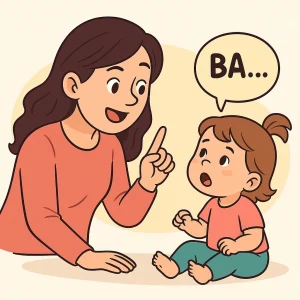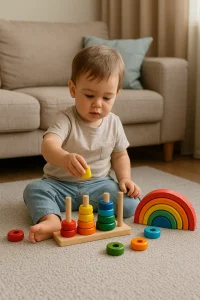15 Best Speech Exercises to Help Kids With Cluttering
By Rajini D
Last Updated: April 15, 2025
Speech cluttering can be a puzzling speech disorder, affecting the way children articulate and organize their words. Unlike more commonly discussed speech issues like stuttering, cluttering often goes unnoticed—yet it significantly impacts a child’s ability to communicate effectively. Children with cluttering tend to speak rapidly, jumble their sentences, or insert unnecessary fillers into their speech, making understanding them quite challenging. Integrating speech exercises for children with cluttering can significantly improve clarity and communication.
Recognizing and addressing speech cluttering early is crucial. Early intervention can dramatically improve the clarity and effectiveness of a child’s communication, enhancing their confidence and social skills. It’s not just about making them understood—it’s about empowering them to express their thoughts and emotions clearly and confidently. This foundational step is essential for their academic success and social integration.
By tackling speech cluttering head-on with targeted exercises, parents and therapists can help children overcome these hurdles, setting them up for a lifetime of clearer communication. Let’s explore how dedicated speech therapy strategies can make a significant difference in the lives of children dealing with cluttering.
Want expert guidance to complement these exercises? Explore our online speech therapy for cluttering to get personalized support tailored to your child’s needs.
Understanding Speech Cluttering in Children
Speech cluttering is a fluency disorder that affects how a person’s speech is perceived. It’s characterized by bursts of rapid speech that can be hard to understand, excessive interruptions, and a disorganized flow of thoughts. This can result in listeners finding it difficult to follow what the child is saying, which often leads to misunderstandings or requests for repetition.
Read more: Cluttering Speech Explained: Causes, Symptoms and Help
Common Symptoms of Speech Cluttering
- Rapid and irregular speech pace: Children with cluttering may speak unusually fast, which compromises their clarity.
- Excessive fillers or pauses: Frequent use of “um,” “uh,” or inappropriate pauses disrupts the flow of speech.
- Revisions and interjections: Frequent corrections or inserting extra words without a clear structure.
- Blending words together: Speech may sound slurred as words are combined or syllables are dropped.
Distinguishing Cluttering from Other Speech Disorders
While cluttering might seem similar to stuttering, the two are distinct. Stuttering primarily involves involuntary repetitions and prolongations of sounds or syllables. In contrast, cluttering is less about the sounds themselves and more about the pacing and organization of speech. Children with cluttering are often unaware of the disfluency, unlike those who stutter and are typically conscious of their difficulties during speech.
Understanding these differences is critical in tailoring interventions appropriately. While stuttering treatments might focus on controlling speech pace and reducing anxiety, cluttering interventions often involve exercises to improve speech planning and execution. This ensures therapies are effectively matched to the child’s specific needs, maximizing the potential for improvement.
Read More: 10 Signs of Cluttering Speech Parents Shouldn’t Ignore
Top 15 Speech Exercises for Cluttering
Helping a child with cluttering involves exercises that enhance their speech clarity and control. Each of these 15 exercises is designed to target specific aspects of speech that children with cluttering need to develop. Let’s explore these exercises:
1. Breathing Techniques for Speech Control
Teach children to control their speech by managing their breath. Start with deep breathing exercises where the child breathes in slowly through their nose, holds for a few seconds, and exhales through their mouth while softly speaking a sound like “ahh.” This helps in controlling the pace and volume of speech.
2. Slow Speech Practice
Encourage slow talking by having the child read a paragraph at half their usual speed using a stopwatch to measure. Discuss the clarity and quality of speech after each session, gradually reducing the time as their control improves.
3. Articulation Exercises
Practice specific, troublesome sounds by using fun words and phrases. For example, if “s” sounds are challenging, have the child repeatedly practice phrases like “Sally sells seashells by the seashore,” focusing on clarity and precision with each repetition.
Know more: Top Articulation Exercises You Can Do at Home for Clearer Speech
4. Phrasing and Pausing Techniques
Instruct the child to read aloud from a favorite book and use intentional pauses at every comma and stop at every period. This breaks the text into manageable chunks and teaches them to take natural breaks in conversation.
5. Using Technology and Apps for Practice
Utilize speech therapy apps that provide visual and auditory feedback. For instance, apps that record and play back the child’s speech can help them hear their own pronunciation and adjust accordingly.
6. Interactive Games that Encourage Clear Speech
Games like charades can be used to encourage articulate speech. The child needs to describe the charade clearly and slowly enough so others can guess, promoting clear articulation under fun pressure.
7. Storytelling and Structured Conversations
Engage the child in creating their own stories or recounting their day with details. This activity helps organize thoughts and present them clearly, focusing on the structure and delivery of their speech.
8. Singing Exercises to Improve Fluidity
Sing songs with varying tempos that require clear articulation of words. Slow songs can help with rhythm and pacing, while faster songs can challenge them to maintain clarity at a quicker pace.
9. Mirror Exercises to Self-Monitor Speech
Have the child practice speaking or reading in front of a mirror. This allows them to see their mouth movements and facial expressions, helping them adjust in real-time for better articulation.
10. Tongue Twisters and Speech Drills
Use progressively difficult tongue twisters to challenge speech precision. Begin with short twisters like “Betty bought some butter” and increase complexity to longer ones like “Peter Piper picked a peck of pickled peppers.”
11. Positive Feedback Techniques
Implement a reward system where the child receives positive reinforcement for clear and correctly articulated phrases. Rewards can be simple stickers or points towards a larger reward, encouraging consistent effort.
12. Role-Playing Scenarios
Create role-playing games where the child can act out various roles using their new speech skills. For example, playing a teacher explaining a lesson to a class helps them practice clear, slow, and deliberate speech.
13. Visual Aids to Support Communication
Use visual aids such as pictures or flashcards to storyboard a conversation or story. This helps the child visualize the sequence of their speech, planning their words and reducing rushing.
14. Group Therapy Sessions
Participate in sessions with other children, focusing on collaborative speaking exercises like group storytelling or discussion circles, which encourage listening and clear speaking turns.
15. Parent and Child Joint Exercises
Regularly engage in exercises where the parent and child practice new speech techniques together. For example, reading a book aloud together, with each taking turns reading a page, mimics natural conversation pacing and pausing.
Adapting Speech Exercises to Diverse Cultural Backgrounds
Understanding and respecting cultural diversity is essential in speech therapy, as it ensures that the exercises are relevant and sensitive to the unique backgrounds of each child. Culturally sensitive speech therapy recognizes that speech patterns, language norms, and communication styles vary widely across different cultures, and tailoring our approach can significantly improve the effectiveness of therapy.
The Importance of Cultural Sensitivity in Speech Therapy
Cultural sensitivity in speech therapy not only respects the child’s background but also enhances engagement and comfort, leading to more effective learning and communication. It helps in building trust between the therapist and the child, ensuring that the therapy provides a safe space for growth and learning.
Examples of Adapting Exercises to Different Cultural Norms and Languages
- Language Adaptations: Modify exercises to include bilingual elements if the child is from a multilingual family. For example, using tongue twisters or rhymes from both the primary and the community language can make the exercises more relatable and effective.
- Cultural Narratives: Incorporate stories, games, and examples that are culturally familiar to the child during therapy sessions. This can involve using folk tales, culturally relevant scenarios, or popular games from the child’s cultural background to make exercises more engaging.
- Visual Aids: Use culturally appropriate visuals that reflect the child’s environment and experiences. For example, using pictures of local foods, traditional celebrations, or familiar landscapes can help children connect more with the material being used in therapy.
- Family Involvement: Engage family members in the therapy sessions to understand better and incorporate the child’s home communication styles into the therapy. This approach not only improves the child’s comfort and participation but also helps the family support the child’s progress effectively.
Wellness Hub’s Role in Speech Therapy for Cluttering
At Wellness Hub, we are committed to enhancing speech therapy outcomes for children experiencing cluttering. Our approach combines the latest technology with personalized care, ensuring that each child receives therapy tailored to their unique needs.
Dedicated to Improving Speech Therapy Outcomes
Wellness Hub is dedicated to advancing the field of speech therapy through innovative solutions and expert care. We understand that every child’s speech journey is different, and our goal is to provide supportive, effective, and accessible therapy options that cater specifically to the needs of children with cluttering.
Products and Services Tailored to Manage Cluttering
- Personalized Therapy Plans: We offer customized therapy plans that are specifically designed to address the individual challenges faced by each child with cluttering. These plans are developed in collaboration with certified speech-language pathologists who specialize in fluency disorders.
- Therapeutic Apps: Our app include tools that support the practice of speech pacing, articulation, and organization. These interactive features make therapy fun and engaging for children.
- Online Resources: Wellness Hub provides a wealth of resources, including instructional videos, practice exercises, and articles that parents and therapists can access to help support ongoing therapy efforts at home and in clinical settings.
- Training for Parents and Educators: Recognizing the crucial role of consistent practice, we offer workshops and training sessions for parents and educators. These sessions equip them with the skills needed to support their children effectively during daily interactions.
Conclusion
Help your child speak more clearly with our easy, fun speech exercises. At Wellness Hub, we’re dedicated to making speech therapy engaging and effective. Discover how our personalized plans and interactive apps can transform your child’s communication skills. Don’t wait—start today to see real improvement! Visit Wellness Hub for more resources and support in your journey toward clearer speech. Together, we can help your child express themselves confidently!
Frequently Asked Questions:
1. What is speech cluttering in children?
Speech cluttering is a fluency disorder where children speak rapidly and jumble words, making their speech difficult to understand. It often results in listeners being confused or needing sentences repeated.
2. How can I tell if my child has speech cluttering?
Look for rapid speech, excessive fillers like ‘um’ or ‘uh,’ and frequent corrections or interruptions in their speech, which are common signs of speech cluttering.
3. Why is early intervention important for speech cluttering?
Starting treatment early can significantly improve your child’s speech clarity, making it easier for them to communicate and interact socially, which boosts their overall confidence.
4. What are some simple speech exercises I can do at home?
Engage your child in slow speech practice by stretching out sentences and using pauses, or involve them in storytelling to help organize their thoughts and speak more clearly.
5. Can apps help my child with speech cluttering?
Yes, specialized speech therapy apps provide interactive and engaging exercises that help children practice and improve their speech pacing and clarity.
6. What role do breathing techniques play in managing speech cluttering?
Controlled breathing exercises help slow down speech and reduce the rapidity that characterizes cluttering, aiding in clearer and more thoughtful speech delivery.
7. How can singing exercises help children with cluttering?
Singing exercises use musical rhythms to help children learn to control the pace of their speech, improving fluidity and reducing the rush in their verbal expressions.
8. Are there group activities that can help with speech cluttering?
Participating in group therapy or playing speech-focused games with peers provides a fun and less pressured environment for children to practice and improve their speech skills.
9. What should I look for in a speech therapist for cluttering?
Choose a speech therapist experienced in fluency disorders, particularly cluttering, who uses a comprehensive approach with customized exercises to address your child’s specific needs.
10. How does Wellness Hub support children with speech cluttering?
Wellness Hub provides tailored speech therapy plans, incorporates advanced apps, and offers resources designed specifically for children with cluttering, making therapy both effective and engaging.
About the Author:
Rajini Darugupally
M.Sc., Speech-Language Pathologist (9+ years of experience)
Rajini is a passionate and dedicated Speech-Language Pathologist with over 9+ years of experience, specializing in both developmental speech and language disorders in children and rehabilitation in adults. Driven by a desire to empower each individual to find their voice, Rajini brings a wealth of experience and a warm, genuine approach to therapy. Currently, at Wellness Hub, she thrives in a team environment that values innovation, compassion, and achieving results for their clients.
Book your Free Consultation Today
Parent/Caregiver Info:
Client’s Details:
* Error Message








